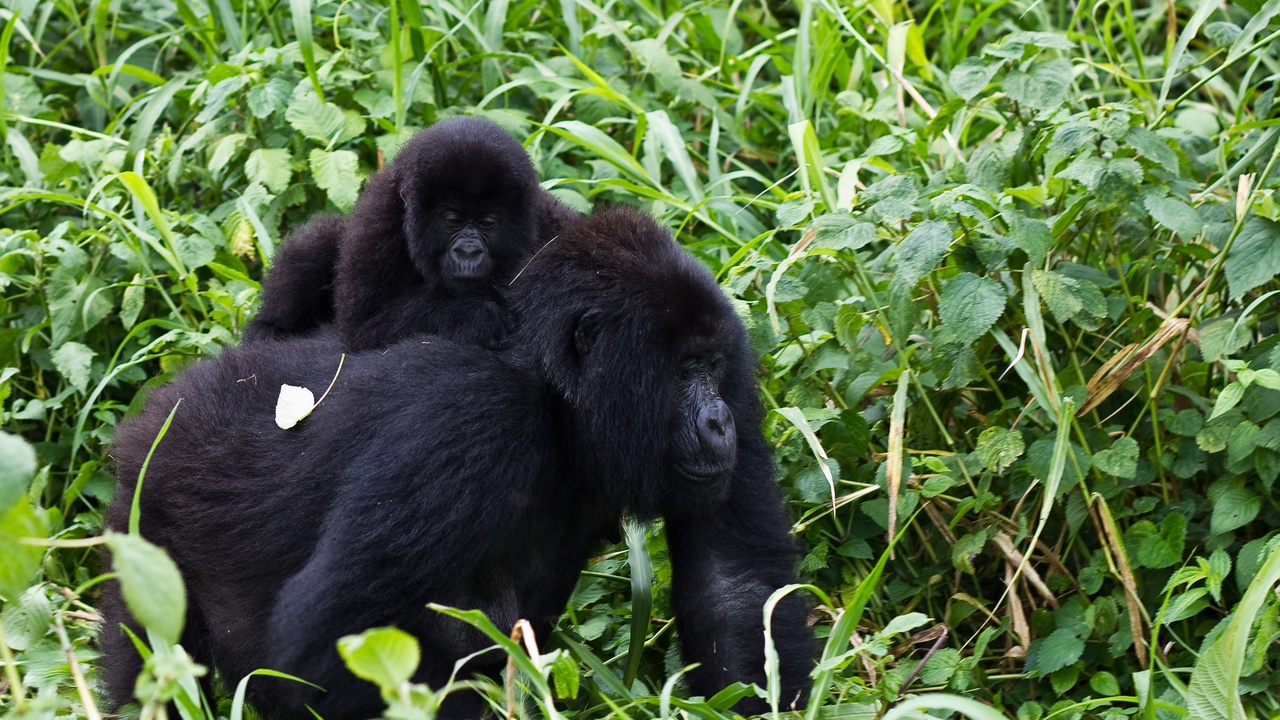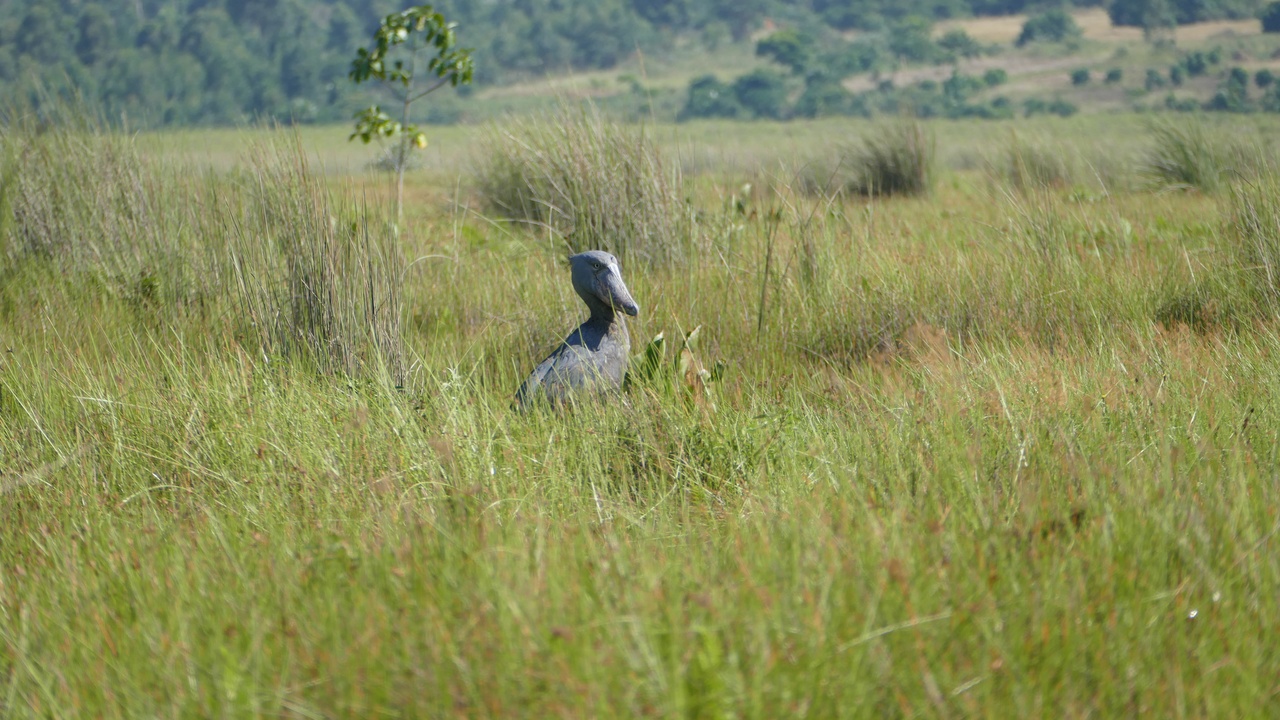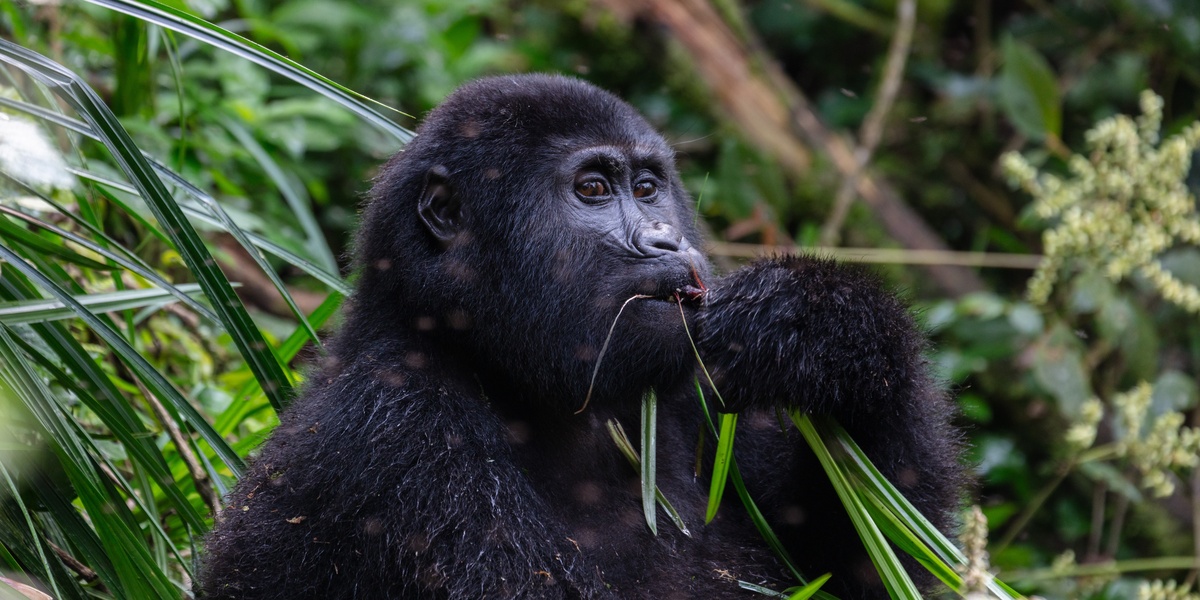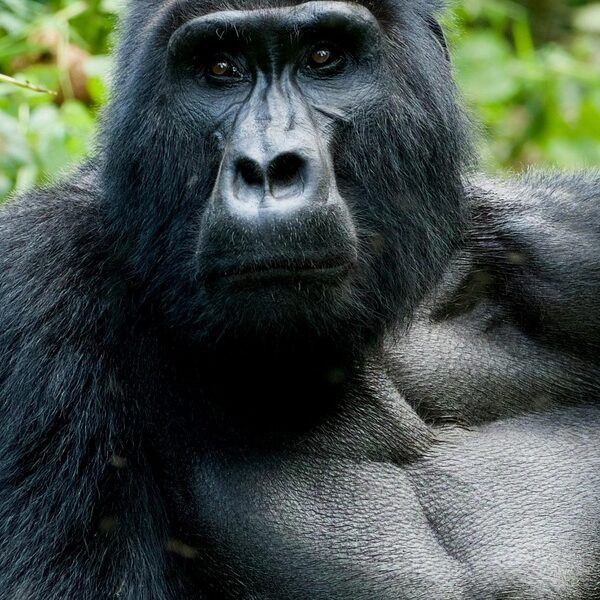In 1901, the first scientific accounts of Uganda’s mountain gorillas in the Virunga region set off a global fascination with East Africa’s wildlife. That early moment still matters: it helped launch decades of research, tourism, and conservation that link local livelihoods to species survival.
The fauna of uganda spans forests, savannahs, wetlands, and rift highlands and includes roughly 1,000 bird species and hundreds of mammals (BirdLife International, Uganda Wildlife Authority). Those numbers translate into jobs, scientific knowledge, and vital ecosystem services—from pollination to water filtration—so the stakes are both ecological and economic.
Primates and Large Mammals

Uganda’s great apes and big mammals are conservation icons and major income generators through ecotourism. Protected areas such as Bwindi, Mgahinga, Queen Elizabeth and Murchison Falls host these species and help channel revenue and jobs into neighbouring communities; the Uganda Wildlife Authority manages many of the permit and revenue-sharing programs.
1. Mountain Gorilla — Conservation flagship and ecotourism draw
Mountain gorillas are Uganda’s most famous conservation success story and a major tourism magnet. Recent estimates put the Virunga and Bwindi populations at over 1,000 individuals combined (IUCN/UWA), a recovery driven by intensive protection and community programs (IUCN; UWA).
Gorilla permits generate substantial foreign exchange and create jobs for trackers, guides and park staff, while community revenue-sharing supports schools and clinics around Bwindi Impenetrable National Park. The Buhoma Community Rest Camp and other local initiatives are concrete examples of tourism dollars staying local.
2. African Elephant — Keystone species and tourism revenue
African elephants shape savannah and forest structure by opening pathways, creating water access and dispersing seeds, so they’re true keystone species. Significant herds inhabit Murchison Falls and Queen Elizabeth parks; national estimates vary by survey but UWA and IUCN monitoring show localized recoveries and persistent threats from poaching and habitat loss.
Elephants attract safari bookings and photographic tourism, and anti-poaching units—often supported by international partners—work with community scouts to reduce illegal killing. Programs around Murchison and Karuma also include human–elephant conflict mitigation such as fortified kraals and early-warning systems.
3. African Lion — Apex predator and ecosystem balancer
Lions are apex predators that help regulate herbivore numbers and maintain savannah balance, with good sightings in Queen Elizabeth and Kidepo Valley National Parks. Regional surveys suggest fluctuating populations; conservationists use camera-trap data and community reporting to track trends and target interventions.
Where livestock losses occur, programs that promote boma strengthening, compensation schemes and community conservancies have reduced retaliatory killings and helped secure both livelihoods and lion packs for tourism viewing.
4. Chimpanzee — Genetic cousin and research subject
Chimpanzees in Kibale National Park and nearby forests are central to behaviour and health research and are a major draw for visitors. Kibale hosts some of Africa’s highest primate densities, and long-term projects—such as the Kibale Chimpanzee Project—provide data used in conservation and medical studies (UWA).
Chimp tracking supports guide incomes and trains local people in wildlife monitoring, while research findings inform both park management and global science.
Birdlife and Wetland Specialists

Uganda is a top birding destination with around 1,000 species recorded (BirdLife International), and its wetlands—Mabamba, Lake Victoria fringes and papyrus swamps—support many specialist birds. Birdwatching brings niche tourism revenue and uplifts community guide enterprises.
5. Shoebill — Iconic wetland specialist and birdwatching prize
The shoebill’s prehistoric profile makes it a must-see for birders and a headline species for Mabamba Bay tours. The species is listed on the IUCN Red List and is vulnerable to wetland drainage and disturbance (IUCN), so responsible viewing is critical.
Community-run boat trips at Mabamba generate guide income and provide economic incentives to keep papyrus intact, turning tourism interest directly into habitat protection.
6. Grey Crowned Crane — National symbol and cultural icon
The grey crowned crane is Uganda’s national bird and features in ceremonies and cultural imagery. It receives legal protection, but populations have declined due to wetland loss and illegal capture for trade, prompting awareness and captive-breeding efforts supported by local NGOs.
Conservation education that links the crane to cultural pride helps reduce threats, and agro-ecological measures—retaining wetland patches on farmland—benefit both cranes and farmers.
7. African Fish Eagle — Indicator of healthy waterways
The African fish eagle’s call is synonymous with productive lakes and rivers. Abundant eagle sightings often reflect healthy fish stocks, so birders and anglers watch them as a simple, visible indicator of aquatic ecosystem condition (common at Lake Victoria, Lake Mburo and the Nile near Jinja).
Healthy fish populations support recreational tourism and local fisheries, and eagle-focused boat trips are a small but steady income stream for lakeside guides.
8. Papyrus specialists (e.g., Papyrus Gonolek) — Wetland endemics and ecosystem engineers
Papyrus swamps are distinctive ecosystems that host range-restricted species such as the Papyrus Gonolek and several papyrus warblers. Papyrus also helps control floods, filter water and sequester carbon, so protecting these swamps yields clear human benefits.
Efforts around Mabamba and the Lake Victoria fringes show that community wetland management—combined with income from eco-tours—keeps papyrus intact and sustains the birds that depend on it.
Reptiles, Amphibians, and Invertebrates

Lesser-known taxa—reptiles, amphibians and insects—perform vital ecosystem functions like pollination, pest control and nutrient cycling. The Albertine Rift in western Uganda is a hotspot for endemic amphibians, making targeted protection essential for these groups.
9. Nile Crocodile — Top aquatic predator with human-wildlife interactions
The Nile crocodile controls fish and waterbird populations across lakes and river channels, with good sightings at Lake Mburo and along the Nile. Their presence influences fisheries dynamics and local livelihoods, and managers balance tourism with safety through boat protocols and signage.
Communities near rivers often use awareness campaigns and designated water access points to reduce risky encounters, while crocodile-viewing adds to boat-trip income in protected areas.
10. Nile Monitor and other reptiles — Scavengers and ecosystem cleaners
Nile monitors and medium-sized reptiles eat carrion, control invertebrate prey and help recycle nutrients. Though under-recorded, field surveys routinely spot them near waterholes and lodge grounds, signalling functioning food webs.
Including reptiles in biodiversity monitoring gives managers a fuller picture of habitat quality and can reveal degradation before larger species are affected.
11. Albertine Rift Endemic Frogs — High endemism and conservation importance
The Albertine Rift hosts dozens of amphibian species found nowhere else, and several recent surveys and IUCN assessments document high levels of endemism in Rwenzori and surrounding forests. Amphibians respond quickly to temperature and moisture changes, so they’re effective bioindicators of environmental stress.
Conservation actions include habitat protection in montane reserves and disease monitoring for threats such as chytrid fungus; researchers and park staff collaborate to track populations at sites like the Rwenzori and Mgahinga ranges.
12. Butterflies and Pollinators — Tiny species with big ecosystem roles
Pollinators—bees, butterflies and other insects—support coffee, fruit and wild-plant reproduction and thus underpin rural livelihoods. Entomological surveys record hundreds of butterfly species in Uganda, and butterfly farms and pollinator-friendly farming practices provide alternative income and education for communities.
Protecting pollinators boosts crop yields, preserves wild plant diversity and creates tourism niches such as butterfly-house visits and guided insect walks in western Uganda.
Summary
Uganda’s wildlife ranges from headline species like gorillas and shoebills to lesser-known frogs and pollinators, and all of them matter for ecology and people. Support for conservation through smart tourism and partnerships keeps species and communities viable.
- Mountain gorilla tourism (managed by UWA) generates direct local income and funds community services.
- Wetlands such as Mabamba and Lake Victoria papyrus provide habitat for specialists like the shoebill and deliver water filtration, flood control and carbon storage.
- The Albertine Rift concentrates amphibian endemism, making targeted protection crucial for global biodiversity.
- Smaller organisms—crocodiles, monitors, pollinators and butterflies—sustain fisheries, nutrient cycles and crop production, so conserving them supports rural economies.
- Learn more and support reputable groups such as Uganda Wildlife Authority, BirdLife International and the IUCN through responsible tourism, donations or simply spreading the word about conservation.





